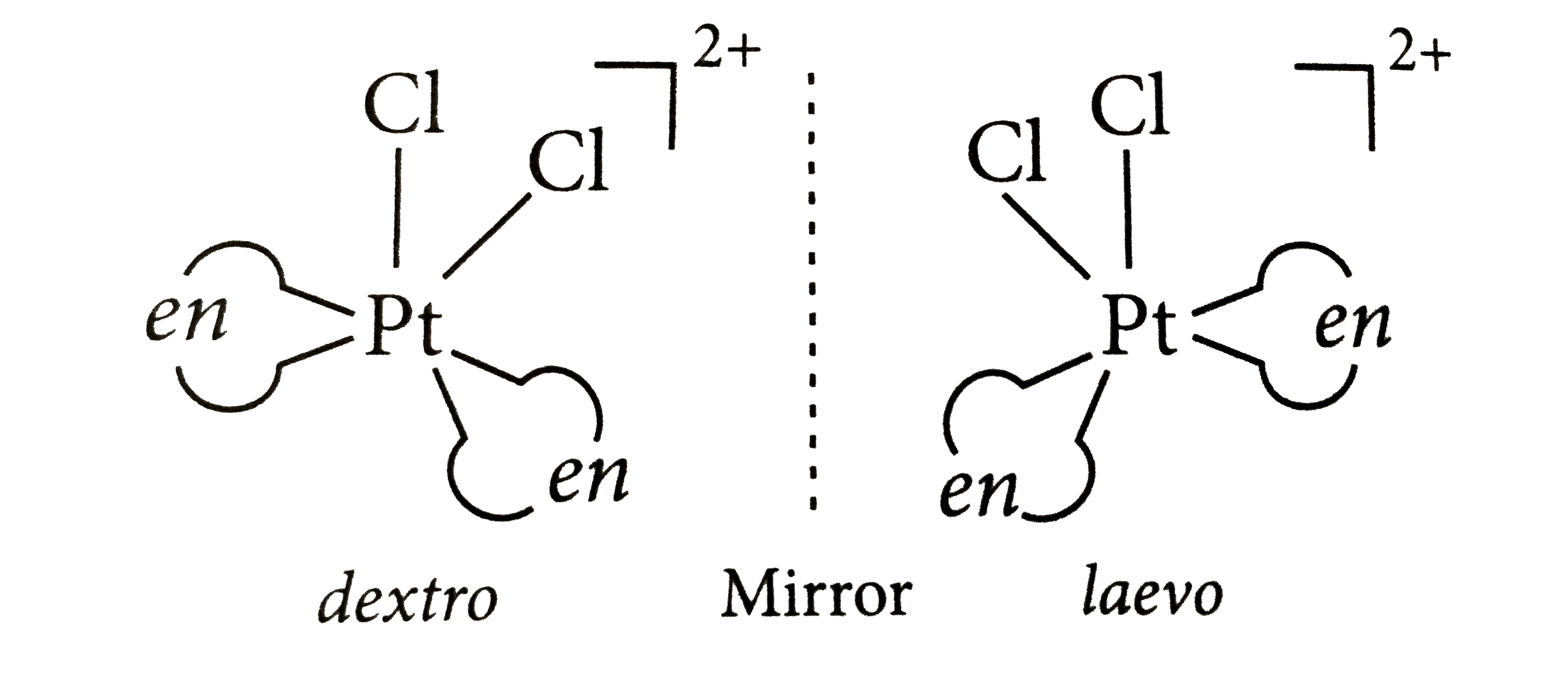Assertion : In a coordination entity [PtCl2(en)2]2+ only the cis-isomer shows optical activity .
Reason : Optical isomerism is common in octahedral complexes involving didentate ligands .
If both Assertion and reason are true and reason is the correct explanation of assertion
If both assertion and reason are true but reason is not the correct explanation of assertion
If assertion is true but reason is false
if both assertion and reason are false
The correct Answer is:B
Only cis- form will have non-superimposable mirror image.

Topper's Solved these Questions
- COORDINATION COMPOUNDS BOOK - NCERT FINGERTIPSCHAPTER - COORDINATION COMPOUNDS EXERCISE - NCERT Exemplar
14 Videos
- CHEMISTRY IN EVERYDAY LIFE BOOK - NCERT FINGERTIPSCHAPTER - CHEMISTRY IN EVERYDAY LIFE EXERCISE - Assertion And Reason
15 Videos
- ELECTROCHEMISTRYBOOK - NCERT FINGERTIPSCHAPTER - ELECTROCHEMISTRYEXERCISE - Assertion And Reason
15 Videos
Similar Questions
Isomerism - Optical Isomerism (2)
View SolutionGeometrical isomerism arises in heteroleptic complexes due to different possible geometrical arrangement of the ligands. Important examples of this behaviour are found with coordination number 4 and 6. Such isomerism is not possible for a tetrahedral geometry but it is possible for square planar as well as octahedral complexes. Optical square planar as well as octahedral complexes. Optical square planar as well as octahedral complexes. Optical isomers are mirror images that cannot be superimposed on one another. These are called enantiomers. Optical isomerism is common in octahedral complexes involving bedentate ligands.
The total number of isomers possible for the complex [Co(en)2Cl2]+ is :
View Solution
Knowledge Check
The complex entity which shows geometrical as well as optical isomerism, is :
A[Co(gly)3]B[Co(gly)(NH3)4]2+C[CoCl2(NH3)4]DAll of theseThe complex entity which shows geometrical as well as optical isomerism, is :
A[Co(gly)3]B[Co(gly)(NH3)4]2+C[CoCl2(NH3)4]DAll of theseGeometrical isomerism arises in heteroleptic complexes due to different possible geometrical arrangement of the ligands. Important examples of this behaviour are found with coordination number 4 and 6. Such isomerism is not possible for a tetrahedral geometry but it is possible for square planar as well as octahedral complexes. Optical square planar as well as octahedral complexes. Optical square planar as well as octahedral complexes. Optical isomers are mirror images that cannot be superimposed on one another. These are called enantiomers. Optical isomerism is common in octahedral complexes involving bedentate ligands.
The total number of isomers possible for the complex [Co(en)2Cl2]+ is :A3B4C5D2
Geometrical isomerism arises in heteroleptic complexes due to different possible geometrical arrangement of the ligands. Important examples of this behaviour are found with coordination number 4 and 6. Such isomerism is not possible for a tetrahedral geometry but it is possible for square planar as well as octahedral complexes. Optical square planar as well as octahedral complexes. Optical square planar as well as octahedral complexes. Optical isomers are mirror images that cannot be superimposed on one another. These are called enantiomers. Optical isomerism is common in octahedral complexes involving bedentate ligands.
Which one of the following statements is false ?
View SolutionGeometrical isomerism arises in heteroleptic complexes due to different possible geometrical arrangement of the ligands. Important examples of this behaviour are found with coordination number 4 and 6. Such isomerism is not possible for a tetrahedral geometry but it is possible for square planar as well as octahedral complexes. Optical square planar as well as octahedral complexes. Optical square planar as well as octahedral complexes. Optical isomers are mirror images that cannot be superimposed on one another. These are called enantiomers. Optical isomerism is common in octahedral complexes involving bedentate ligands.
Select the correct statement.
View SolutionGeometrical isomerism arises in heteroleptic complexes due to different possible geometrical arrangement of the ligands. Important examples of this behaviour are found with coordination number 4 and 6. Such isomerism is not possible for a tetrahedral geometry but it is possible for square planar as well as octahedral complexes. Optical square planar as well as octahedral complexes. Optical square planar as well as octahedral complexes. Optical isomers are mirror images that cannot be superimposed on one another. These are called enantiomers. Optical isomerism is common in octahedral complexes involving bedentate ligands.
Which one of the following statements is false ?
View SolutionGeometrical isomerism arises in heteroleptic complexes due to different possible geometrical arrangement of the ligands. Important examples of this behaviour are found with coordination number 4 and 6. Such isomerism is not possible for a tetrahedral geometry but it is possible for square planar as well as octahedral complexes. Optical square planar as well as octahedral complexes. Optical square planar as well as octahedral complexes. Optical isomers are mirror images that cannot be superimposed on one another. These are called enantiomers. Optical isomerism is common in octahedral complexes involving bedentate ligands.
Select the correct statement.
View SolutionGeometrical isomerism arises in heteroleptic complexes due to different possible geometrical arrangement of the ligands. Important examples of this behaviour are found with coordination number 4 and 6. Such isomerism is not possible for a tetrahedral geometry but it is possible for square planar as well as octahedral complexes. Optical square planar as well as octahedral complexes. Optical square planar as well as octahedral complexes. Optical isomers are mirror images that cannot be superimposed on one another. These are called enantiomers. Optical isomerism is common in octahedral complexes involving bedentate ligands.
Which of the following complexes will show geometrical isomerism ?
View Solution
